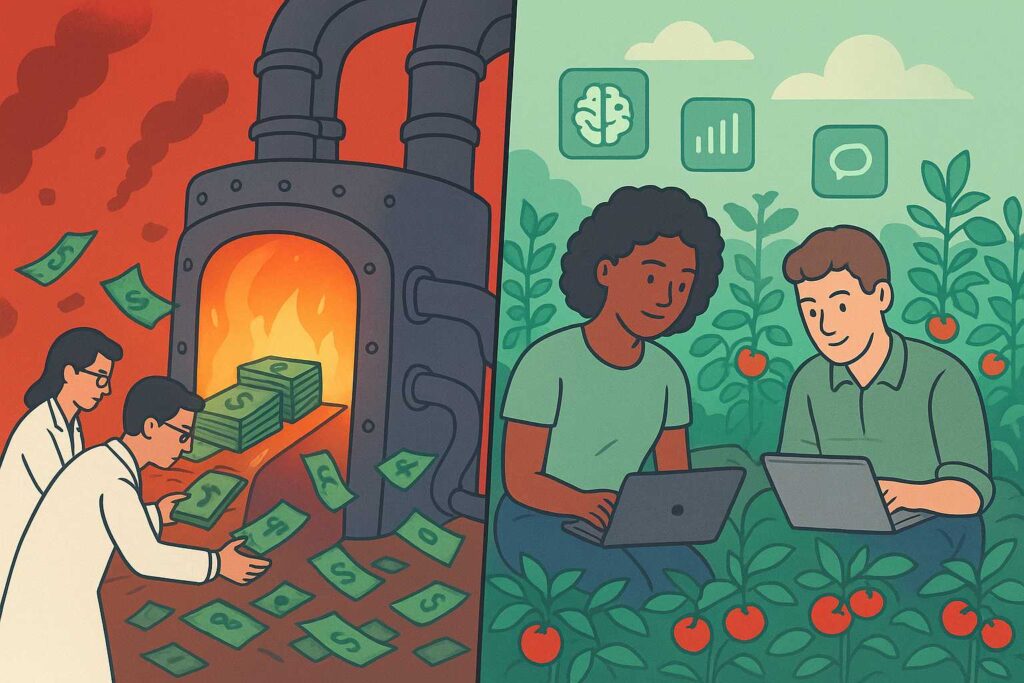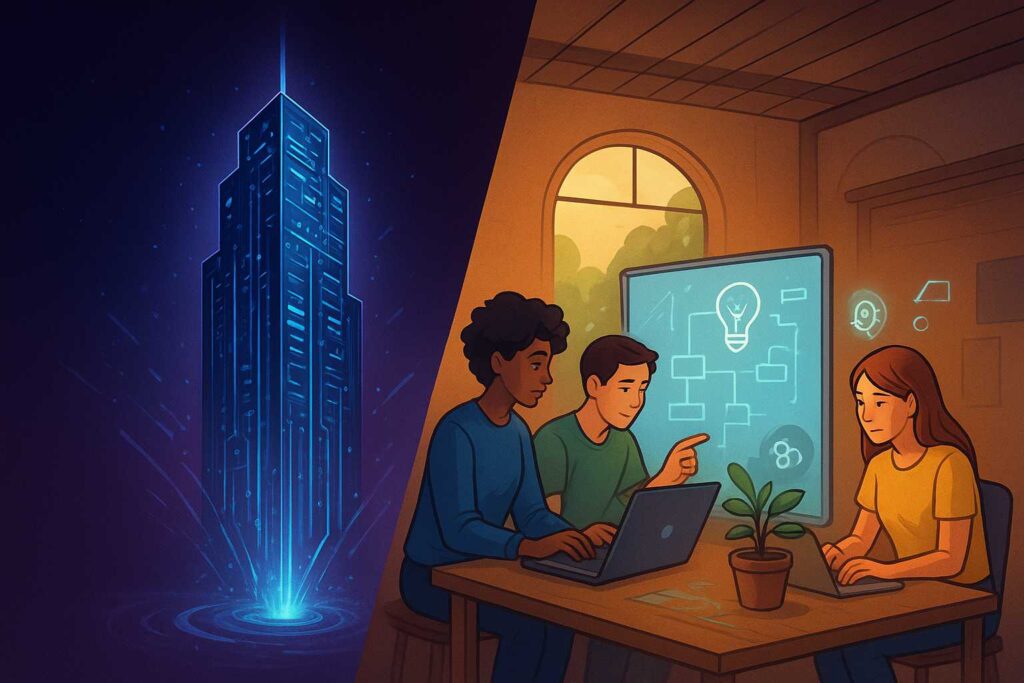I’ve been researching how artificial intelligence is developing over the past few months. Not just the splashy news about billion-dollar investments, either, but also the more subtle trends that are shaping the future.
What I discovered is a story of two radically different visions of AI, one whose prospects look increasingly unsustainable and another that is easily overlooked, even though it is actually shaping our times.
I think this split is what accounts for the fact that the AI boom feels like a bubble at the top, where real innovation in AI is happening elsewhere. Now, let me take you through what I’ve learned and see the AI Bubble vs. The Real Revolution facts.

Big Tech’s Costly Gamble on AI
When AI is on people’s minds, the names they first mention tend to be tech giants like Microsoft, Google, Amazon or Meta. They feature in the headlines with massive announcements, impressive demos, and the promise of Artificial General Intelligence (AGI).
But what often goes unsaid is the breathtaking price of this ambition. The largest players are now pouring hundreds of billions of dollars each year into computer infrastructure, specialized chips and immense data centers.
From what I’ve seen, the combined annual capital spending of the top companies has more than doubled compared to a decade ago, and much of that is going toward AI initiatives.
The logic goes something like this: Develop the most powerful, general AI systems possible and ultimately, profits will follow.
But when I dig into the economics, it just doesn’t make sense, at least, not yet. These large models are notoriously expensive to run, and the actual gains from them are uncertain.
It feels more like a competition to outspend one another than to build sustainable value.
The Other Side of the AI Story
What excites me far more is what’s going on outside those massive corporations. In my own quest, I’ve met numerous smaller teams, startups, individual developers, and open-source communities that are approaching AI in a fundamentally different manner.
Instead of pouring billions into giant models that strive to do everything, these innovators are taking the tools we already have and tuning them to solve narrow, real-world problems.
They’re constructing systems that may not be sleek at first glance but are proving to bring results for businesses and communities.
Consider a small company that trains a model to analyze contracts in the legal industry. Or developers who build AI-powered search engines for small markets, like health care or real estate.
I’ve seen even farmers apply lightweight AI systems to monitor crops and increase yield, without having to match the stratospheric budgets of Silicon Valley.
This movement isn’t big news every week, but it’s already proving its value by doing things that are profitable and sustainable.
Why Small and Specialized Models Matter?

I discovered one of the most interesting things while researching is how quickly the world of open-source AI is growing.
The count of a handful of pre-trained models has now skyrocketed on platforms such as Hugging Face, a sign that the developer community keeps on pushing the AI bar at an incredible speed.
This explosion of tiny, specialized models also suggests a very different future for AI: rather than a few, massive systems that dominate everything, we are more likely to have thousands of these smaller models, all customized for one tiny set of tasks.
And this makes sense. Large, general-purpose models are potent, but they are also inefficient.
They’re trying to account for every possibility, which can make things heavy and expensive. Smaller models, tuned for a specific job, are often quicker, less expensive and more accurate at doing that job.
And that efficiency is just what businesses crave. Why buy a big, clunky tool when a svelte, custom-made one does the job right?
The Philosophical Divide
When thinking about that contrast, I see two very different approaches guiding AI:
- The big players are taking the top-down approach, and the intent is to consolidate power into a handful of massive systems.
- The bottom line that developers and startups cling to is distribution and specialisation.
History gives us some clues here. The mainframe once seemed invincible, until personal computers appeared.
I understand the winners in both scenarios weren’t the most massive or powerful machines. They were more versatile, personal and inexpensive. I believe AI is at a similar turning point right now.
Why the AI Bubble Could Burst?
As much as I admire the breakthroughs from large firms, I can’t ignore the warning signs. Costs are escalating faster than revenues.
Shareholders are already asking if spending will know no limits. And the target of genuine AGI still seems a long way off, possibly decades.
This mismatch leads me to believe we are experiencing an AI bubble. Not that AI will be gone, not by a long shot. But not that the big players’ strategy of pursuing it may not be financially sustainable.
At some point, markets demand balance. You can’t indefinitely keep setting money on fire with uncertain payout. And when that correction arrives, it’s the smaller, leaner players that are best positioned to win.
How Startups Are Turning Flaws Into Opportunities
There is a thing in Japanese art called Kintsugi, where broken pottery is mended with gold, and it makes cracks into things of beauty. That sentiment reflects what I am seeing in the AI startup world.
Large, generalist models have plenty of flaws, inefficiencies, high costs, and gaps in performance. And instead of attempting to fix those weaknesses on a huge scale, smaller companies are actively exploiting them. They are therapists who turn flawed instruments into valuable, customized solutions.
It’s this ability to turn “cracks” into opportunities that convinces me the next wave of successful AI companies will emerge from this bottom-up movement.
What This Means for the Future?
I’ve spent months exploring this topic, and three big things have emerged for me.
- The current AI boom at the top is unsustainable. The money that’s being spent doesn’t justify the return.
- The real AI revolution is happening in the trenches. Startups and open-source developers are solving real problems today using lightweight, specialized models.
- History favors the practical over the powerful. The way that PCs beat mainframes and mobile beat PCs, smaller, adaptable AI entities are likely to win the long game.
For anyone paying attention, the lesson is clear: don’t just stare at the big announcements and the billion-dollar investments. The more interesting scene is playing out on a much smaller stage.
Final Thoughts
It’s easy to be overwhelmed by headlines about giant AI models and trillion-dollar companies fighting for the future of the industry. But as I’ve discovered, the quieter revolution is far more interesting, and in the long run, far more significant.
So if you ask me where the future of AI is being written, I’d argue that it’s not in shiny corporate boardrooms or billion-dollar data centers.
It’s left up to developers, entrepreneurs and open communities that are transforming ideas into workaday tools. That is where the revolution is quietly happening, and that is the part to keep an eye on.

